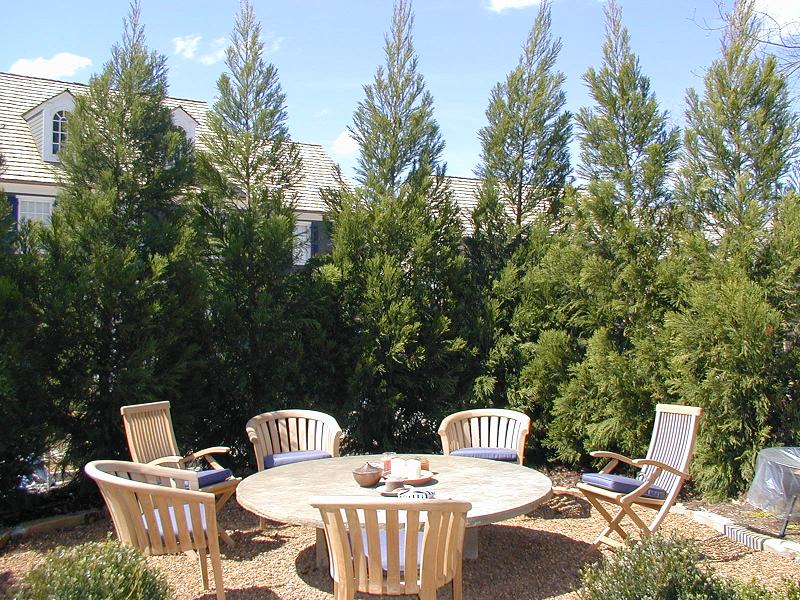
Or help "drought-scaping?"
Check out our Design Services.
We're also offering a 10% discount
for November & December Appointments
| Plants for Screening |

|
Need design help? Or help "drought-scaping?" Check out our Design Services. We're also offering a 10% discount for November & December Appointments |
| Name | Size (HxW) | Growth Rate | Drought Tolerance; Comments |
|
Leyland Cypress Cupressus × leylandii |
50x10-20 | Very Rapid |
Fair; Over-used |
|
Green Giant Arborvitae Thuja 'Green Giant' |
30-40x15-20 | Rapid |
Good; Nice texture |
|
Eastern Red Cedar Juniperus virginiana |
30-40x10-20 | Mod/Rapid |
Excellent; Native |
|
Southern Magnolia Magnolia grandiflora |
30-40x10-20 | Slow/Mod |
Fair; Messy leaves |
|
Japanese Cedar Cryptomeria japonica |
50-60x20-30 | Moderate |
Good; Nice texture |
|
Deodar Cedar Cedrus deodara |
40-70x30-40 | Moderate |
Good; Nice texture, open |
|
Arizona Cypress Cupressus arizonica |
30-40x15-20 | Rapid |
Excellent; Gray/blue color |
|
Blue Atlas Cedar Cedrus atlantica 'Glauca' |
60-100x40 | Rapid |
Excellent; Blue color |
|
Chinese Evergreen Oak Quercus myrsinifolia |
20-40x20-30 | Slow |
Good; Uncommon tree |
|
American Holly Ilex opaca |
30-60x15-30 | Slow |
Good; Native |
|
Nellie Stevens Holly Ilex x 'Nellie R. Stevens' |
30-40x10-15 | Rapid |
Excellent; Dense foliage |
| Name | Size (HxW) | Growth Rate | Drought Tolerance; Comments |
|
Emerald Arborvitae Thuja occidentalis 'Smaragd' |
15-20x3-5 | Mod/Rapid |
Good; Columnar shape |
|
Foster Holly Ilex x attenuata 'Fosteri' |
20-30x10 | Rapid |
Good; Attractive bark |
|
Chinese Holly Ilex cornuta |
15-25x10-15 | Moderate |
Excellent; Easily pruned |
|
Emily Burner Holly Ilex x ‘Emily Bruner’ |
15-20x8 | Moderate |
Good Pyramidal shape |
|
Savannah Holly Ilex x 'Savannah' |
25-30x10-15 | Rapid |
Good; Light green leaves |
|
Yaupon Holly Ilex vomitoria |
15-20x10-20 | Mod/Rapid |
Excellent; Coastal native |
|
Hinoki False Cypress Chamaecyparis obtusa |
Varies by cultivar | Moderate |
Good; Multiple cultivars |
|
Japanese False Cypress Chamaecyparis pisifera |
Varies by cultivar | Moderate |
Good; Multiple cultivars |
|
Little Gem Magnolia M. grandiflora 'Little Gem' |
15-20x8-10 | Slow |
Fair; Dwarf magnolia |
|
Devilwood Osmanthus americanus |
15-25x10-15 | Moderate |
Good; Native tea olive |
|
Fragrant Tea Olive Osmanthus fragrans |
10-20x10-15 | Moderate |
Good; Fragrant fall flowers |
| Name | Size (HxW) | Growth Rate | Drought Tolerance; Comments |
|
Bright n Tight Laurel Prunus caroliniana 'Monus' |
8-10x6-8 | Mod/Rapid |
Good; Shade tolerant |
|
Florida Leucothoe Agarista populifolia |
10-12x10-12 | Mod/Rapid |
Good; For shade |
|
Aucuba Aucuba japonica |
6-10x6-8 | Slow/Mod |
Excellent; Sun or shade |
|
Japanese Cleyera Cleyera japonica |
8-12x6-10 | Moderate |
Good; Sun or shade |
|
Boxwood Buxus spp. |
Varies by cultivar | Slow |
Good; Tolerates part shade |
|
Japanese Camellia Camellia japonica |
8-15x8-10 | Slow |
Good; Partial shade |
|
Sasanqua Camellia Camellia sasanqua |
6-10x5-8 | Mod/rapid |
Good; Partial shade |
|
Japanese Plum Yew Cephalotaxus harringtonia |
Varies by cultivar | Slow |
Excellent; Prefers some shade |
|
Gardenia Gardenia spp. |
Varies by cultivar | Moderate |
Good; Fragrant flowers |
|
Yellow Anise Illicium parviflorum |
8-10x8-10 | Moderate |
Good; Prefers part shade |
|
Junipers Juniperus spp. |
Varies by cultivar | Mod/rapid |
Excellent; Variety of cultivars |
|
Southern Wax Myrtle Morella cerifera |
10-15x8-10 | Very rapid |
Excellent; Handles tight pruning |
|
Loropetalum Loropetalum chinense |
Varies by cultivar | Rapid |
Excellent; Purple-ish leaves |